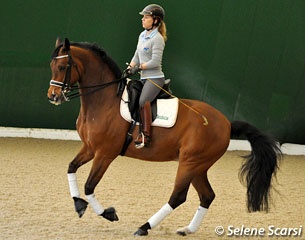
In an area famed for its Barolo and Spumante, a different type of wine is paving the way for a new kind of vintage emerging from within the sprawling vineyards of the Asti hills. Chablis, a famous white from Burgundy, has a legacy in these parts too, albeit a four-legged one: he is the horse with whom Valentina Truppa celebrated her first big successes as a Young Rider, and who kick-started her ascent in senior international dressage.
“Chablis is the epitome of genius and wildness, a horse too clever for his own good at times. And Valentina’s only boyfriend, as we always joke,” says, with a smile, O-judge Dr Enzo Truppa, a former Olympian himself, and father-cum-trainer of Italy’s dressage prodigy.
Valentina will step into her father’s footprints this summer when she becomes the sole Italian representative for dressage in London. Chablis helped get her where she is now, but it is on board Eremo del Castegno that she will be potentially bidding for Italy’s first-ever dressage medal, donning her tailcoat once again, as uniforms are not allowed under IOC rules. And the 10-year-old Italian-bred gelding, by Rohdiamant x Weltmeyer, has already made history, taking bronze at the World Cup Final in s’Hertogenbosch this April. Just like the very best wines, Eremo is a horse who has come on so much with age. “Eremo had so much power at the start and he was so over-eager that he would lose his balance if I pushed too much,” explains Valentina; “It has taken time to make him really sit and come up instead of rushing”.
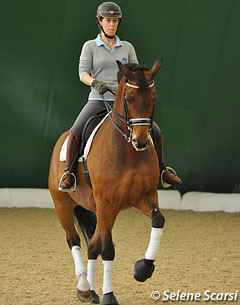 Importantly, Eremo was allowed that time, and time is a word that appears with striking frequency in any conversation with the Truppas. “Horses are a bit like young gymnasts: you cannot ask for everything right from the start”, explains Valentina. “We don't do anything that the horse is not truly able to do. It’s a huge advantage that my dad is my only owner, as this means there is no undue pressure on me to push the horses. We don't have any owners demanding their horses should go out at PSG tomorrow. We own the horses, and therefore we’re able to do it only when they are truly ready”. Eremo is a case in point. “Because of his over-eagerness – when he was eight, you could almost hear him scream ‘What can I do now, what can I do?’–”, chips in Dr Truppa, “a movement such as piaffe could prove difficult: the risk with over-willing horses is that they can become claustrophobic in piaffe. So we always allowed him forwards, even at the risk of sacrificing some marks. It was only last year that Valentina finally asked him to piaffe truly on the spot, and now we probably have one of the very best piaffes on the international circuit.” Time is also the reason why young horse classes are not high up on Valentina’s list of priorities: despite some emerging talents on the yard, the long-term aim is obviously Grand Prix and no youngster is actively campaigned with young horse championships in mind – although she doesn’t rule out competing in some, if and when the horse in question is ready.
Importantly, Eremo was allowed that time, and time is a word that appears with striking frequency in any conversation with the Truppas. “Horses are a bit like young gymnasts: you cannot ask for everything right from the start”, explains Valentina. “We don't do anything that the horse is not truly able to do. It’s a huge advantage that my dad is my only owner, as this means there is no undue pressure on me to push the horses. We don't have any owners demanding their horses should go out at PSG tomorrow. We own the horses, and therefore we’re able to do it only when they are truly ready”. Eremo is a case in point. “Because of his over-eagerness – when he was eight, you could almost hear him scream ‘What can I do now, what can I do?’–”, chips in Dr Truppa, “a movement such as piaffe could prove difficult: the risk with over-willing horses is that they can become claustrophobic in piaffe. So we always allowed him forwards, even at the risk of sacrificing some marks. It was only last year that Valentina finally asked him to piaffe truly on the spot, and now we probably have one of the very best piaffes on the international circuit.” Time is also the reason why young horse classes are not high up on Valentina’s list of priorities: despite some emerging talents on the yard, the long-term aim is obviously Grand Prix and no youngster is actively campaigned with young horse championships in mind – although she doesn’t rule out competing in some, if and when the horse in question is ready.
Together with time, natural, horse-friendly training methods are the only rules in Asti. “There are no gadgets at all here,” enthuses Dr Truppa. “In the whole yard, there is not one single pair of draw reins – Valentina would not even know how to put them on. George Theodorescu used to say that they are a ‘road to hell’ and we agree with that sentiment. There is no place in proper training for shortcuts like that.”
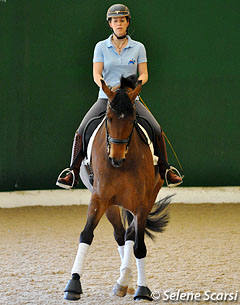 Theodorescu was one of the greatest influences on Valentina’s development as a rider and trainer, but like blending grapes can produce more versatile wines, pieces of wisdom have been happily taken from diverse trainers. “We have worked with Monica Theodorescu and her father; Valentina spent several months at Hubertus Schmidt’s yard a few years ago, and we try and organise clinics with top trainers – such as Jan Bemelmans, Morten Thomsen and, most recently, Wolfram Wittig – coming over to Asti regularly, every three or four months at least. It’s always extremely useful to exchange ideas, and to borrow tips from different trainers. Even if it’s only to get confirmation that the way we are working is correct: you truly never stop learning in this sport and you can be the most successful rider on earth, but you still need to learn.”
Theodorescu was one of the greatest influences on Valentina’s development as a rider and trainer, but like blending grapes can produce more versatile wines, pieces of wisdom have been happily taken from diverse trainers. “We have worked with Monica Theodorescu and her father; Valentina spent several months at Hubertus Schmidt’s yard a few years ago, and we try and organise clinics with top trainers – such as Jan Bemelmans, Morten Thomsen and, most recently, Wolfram Wittig – coming over to Asti regularly, every three or four months at least. It’s always extremely useful to exchange ideas, and to borrow tips from different trainers. Even if it’s only to get confirmation that the way we are working is correct: you truly never stop learning in this sport and you can be the most successful rider on earth, but you still need to learn.”
This medley of different voices has led to the creation of a clearly successful training system which is very much the Truppas’ own. “Each horse is an individual and you can’t just have one single working method for all: it is imperative that you adapt it according to each horse’s particular needs. Even something as simple as the warm-up has to be tailored to each horse’s characteristics – for instance, spirited horses like Eremo or Teknik (Valentina’s first horse) benefit from starting the warm-up with the canter work first, rather than trot,” says Enzo. “Having said that, we do use the same basic system for all horses. Everything is based on gymnasticising, and on perfecting the basics. Sometimes we will play with movements, obviously, but definitely not every day – the main, daily work is purely gymnastic. We use leg-yielding as an important training tool, both as a means of improving suppleness and relaxation in the horse, and therefore riding it quite steeply, and as a developing exercise, alternating it with half-pass, in order to develop reach in the half-passes. In the same way, to improve bend in the ribcage we often incorporate a small circle or volte after the half-pass, so that the horse learns to maintain flexion and bend all the way until the end. We also do lots of counter canter and lots of tempo variations within the counter canter. We always try and ride the corners in counter canter rather than change immediately, even with the really established GP horses. It all helps keep them supple and on the aids, and, this way, the flying change almost becomes a reward”.
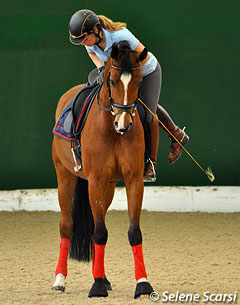 On the subject of rewards, if, whilst training, an exercise is carried out in a particularly satisfactory manner – even something as relatively simple as, for instance, a perfect square halt on the centreline – then Valentina will get off, on the basis that this is the best possible reward for the horse and, therefore, a tool to be exploited.
On the subject of rewards, if, whilst training, an exercise is carried out in a particularly satisfactory manner – even something as relatively simple as, for instance, a perfect square halt on the centreline – then Valentina will get off, on the basis that this is the best possible reward for the horse and, therefore, a tool to be exploited.
“In general, our philosophy is to second the horse, never go against him,” explains Valentina. “For instance, my 7-year-old, Ranieri (a Danish WB by Blue Hors Romanov) can be over-eager at times, a bit like Eremo, and will offer flying changes, but we never, ever punish him for that. He does have to learn to wait for me, so, if I feel he is anticipating, I will do a transition to walk, but we don’t punish him. With even younger horses, we like to lunge them in freedom before riding. That’s another tip we got from George Theodorescu: he encouraged horses to move as they pleased on the lunge for ten minutes or so, so that the rider is then in a better position to ask the horse to concentrate on the work at hand for the next twenty minutes."
Valentina demonstrates this with Nilo del Castegno, a 5-year-old by Stedinger, out of the same dam as Eremo, Weltgirl (Weltmeyer x Consul, a stunning mare who has produced, among others, two international GP horses – Eremo, by Rohdiamant, and Beldonwelt, by De Niro – as well as Fede del Castegno, by Rubinstein, who was hugely successful in young horse classes in Italy). “Nilo can be very cheeky and definitely has a sense of humour,” says Dr Truppa. “So much so that the breeder almost didn’t want us to have him, as he was worried he’d be too sharp! But he’s been here since he was three and he’s really settled now”.
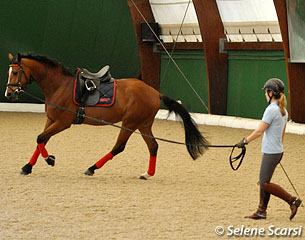 This is undoubtedly helped by the fact that Valentina takes her time with him, not only when riding him but also when handling him from the ground. “I love being around horses – obviously I love riding, but I also just love being with them, spending time with them,” she emphasises as she puts turnout boots on Nilo, who is patiently standing in the cross ties. “I think a horse like Nilo has improved so much in terms of relaxation and self-confidence partly because of the time I spend with him on the ground. I always try to do small stuff like putting bandages on myself, or turning him out myself, so that we can really develop a relationship which can then be advanced under saddle."
This is undoubtedly helped by the fact that Valentina takes her time with him, not only when riding him but also when handling him from the ground. “I love being around horses – obviously I love riding, but I also just love being with them, spending time with them,” she emphasises as she puts turnout boots on Nilo, who is patiently standing in the cross ties. “I think a horse like Nilo has improved so much in terms of relaxation and self-confidence partly because of the time I spend with him on the ground. I always try to do small stuff like putting bandages on myself, or turning him out myself, so that we can really develop a relationship which can then be advanced under saddle."
Valentina’s ample experience with youngsters has come almost out of necessity. “We can’t afford to buy ready-made, world-class Grand Prix horses,” she lucidly explains. “Therefore, we have to make our own! With a few exceptions, we’ve bought most of our horses as 6-month-old foals. They are then broken in at three with horse-friendly, natural horsemanship methods, which is important to us so that, by the time they come to the yard after being broken, we can crack on with their ridden education. Incidentally, I find the ethological approach particularly fascinating – we recently organised a clinic with a Parelli trainer, Sergio Vezzoni, at the end of which I rode Ranieri bareback and Chablis in a headcollar,” she continues. “Of course, the youngsters aren’t ridden every day: I alternate between schooling, hacking and turnout. All the horses go out in the field, to ensure mental, as well as physical, relaxation.” The Truppas buy a few foals most years; in 2011 they bought a full sister to Eremo, a filly called Romea bred by the Castegno stud on Enzo’s request (Weltgirl is not getting any younger, and the Truppas long desired a full sibling to Eremo) as well as a Painted Black foal, Asso Rosso di Fonteabeti, from a different breeding stud, Fonteabeti near Perugia.
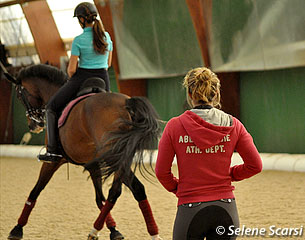 At just 26, Valentina is already passing on what she has learnt in the saddle, ensuring a bright future for dressage in Italy. “I normally ride in the morning and teach in the afternoon; I have some really good students, including Federica Scolari, Maddalena Zambaiti and Micol Rustignoli, who keep their horses at my yard and whom I really enjoy teaching. For some of them it’s a long drive to come to Asti to ride: it’s testament to their motivation and passion”. Federica and Micol will be debuting at their first major international in the Under-25 Grand Prix at the CDI 5* in Munich, in mid-May. It isn’t always easy to find the right balance between riding, competing and teaching, but Valentina enjoys teaching almost as much as she enjoys riding, which makes it easier to combine the two. Incidentally, Micol is riding Valentina’s former GP horse Corallo Nero del Castegno, while Federica is riding another Weltgirl offspring, Beldonwelt. Both Corallo and Beldon, as well as Eremo and Chablis, have been trained up to Grand Prix by Valentina since they were youngsters – no mean feat, considering her young age. Her passion for the horses entrusted in her care transpires when she talks of Corallo: “If it were for me, no horse would be sold, ever – I’d keep them all! With Corallo I have found a truly optimal solution: Micol was horseless after the retirement of her Young Rider team horse and I was finding I had increasingly less time for him because I was campaigning both Chablis and Eremo at international Grand Prix, so she got him on loan. Which works out perfectly for me, because I still get to see him every day! As for Beldonwelt, what can I say? This is a horse who came here when he was working at Novice level and Federica was a teenager. Now they’re about to debut at international Grand Prix. These are huge satisfactions and this is precisely what I mean when I say that training can be just as fulfilling as riding itself”.
At just 26, Valentina is already passing on what she has learnt in the saddle, ensuring a bright future for dressage in Italy. “I normally ride in the morning and teach in the afternoon; I have some really good students, including Federica Scolari, Maddalena Zambaiti and Micol Rustignoli, who keep their horses at my yard and whom I really enjoy teaching. For some of them it’s a long drive to come to Asti to ride: it’s testament to their motivation and passion”. Federica and Micol will be debuting at their first major international in the Under-25 Grand Prix at the CDI 5* in Munich, in mid-May. It isn’t always easy to find the right balance between riding, competing and teaching, but Valentina enjoys teaching almost as much as she enjoys riding, which makes it easier to combine the two. Incidentally, Micol is riding Valentina’s former GP horse Corallo Nero del Castegno, while Federica is riding another Weltgirl offspring, Beldonwelt. Both Corallo and Beldon, as well as Eremo and Chablis, have been trained up to Grand Prix by Valentina since they were youngsters – no mean feat, considering her young age. Her passion for the horses entrusted in her care transpires when she talks of Corallo: “If it were for me, no horse would be sold, ever – I’d keep them all! With Corallo I have found a truly optimal solution: Micol was horseless after the retirement of her Young Rider team horse and I was finding I had increasingly less time for him because I was campaigning both Chablis and Eremo at international Grand Prix, so she got him on loan. Which works out perfectly for me, because I still get to see him every day! As for Beldonwelt, what can I say? This is a horse who came here when he was working at Novice level and Federica was a teenager. Now they’re about to debut at international Grand Prix. These are huge satisfactions and this is precisely what I mean when I say that training can be just as fulfilling as riding itself”.
Text and Photos © Dr. Selene Scarsi for Eurodressage.com
Related Links
Valentina Truppa, Third at 2012 World Cup Finals
Valentina Truppa Sweeps the 2011 Italian Dressage Championships
Valentina Truppa Wins Second Young Riders' World Cup Finals
Italian Valentina Truppa Becomes 2006 European Young Rider Champion
Vincenzo Truppa Embracing Life in All Its Aspects